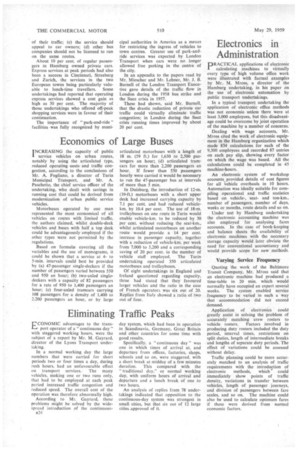Electronics in Administration
Page 58

If you've noticed an error in this article please click here to report it so we can fix it.
DRACTICAL applications of electronic
calculating machines to virtually every type of high volume office work were illustrated with factual examples by Mr.. M. Mross, a director of the Hamburg undertaking, in his paper on the use of electronic automation by public transport undertakings.
In a typical transport undertaking the application of electronic office methods was not economic, unless there were at least 3,000 employees, but this disadvantage could be overcome by joint operation of the machine by a number of concerns.
Dealing with wage accounts, Mr. Mross cited the work of electronic equipment in the Hamburg organization which made 834 calculations for each of the 9,300 employees and recorded 87 entries on each pay slip, showing every factor on which the wage was based. All the calculations could be completed in 45 machine-hours.
An electronic system of workshop accounts provided details of cost figures for all vehicle overhauls in 10 hours. Automation was ideally suitable for compiling operational and traffic statistics based on vehicle-, seatand ton-km., number of passengers, number of days, weeks or months, route details and so on.
Under test by Hamburg undertaking the electronic accounting machine was also employed for analysing fares accounts. In the case of book-keeping and balance sheets the availability of electronic machines with the necessary storage capacity would later obviate the need for conventional accountancy and would provide scope for new methods.




































































































